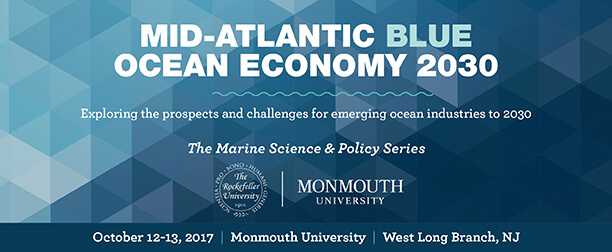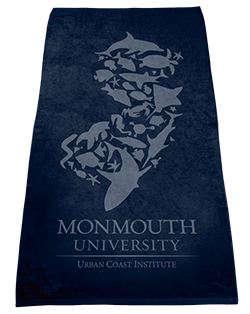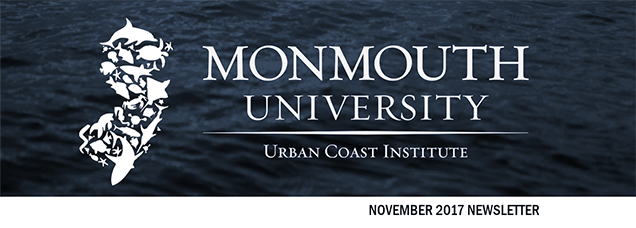
Forum Builds a 2030 Vision for the Mid-Atlantic Blue Ocean Economy
CLICK HERE FOR FORUM VIDEOS & MATERIALS
Summing up how to approach the Mid-Atlantic coast’s formidable future challenges, Aquarium of the Pacific CEO Jerry Schubel invoked hockey legend Wayne Gretzky, who once explained his success as follows: “I skate to where the puck is going to be, not where it has been.”
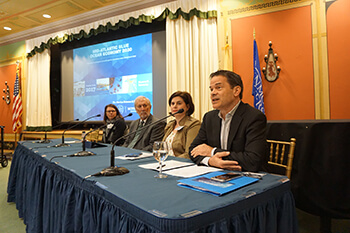 It was a message that resonated with a group of leaders from marine sectors such as shipping, homeland security, fishing, science and tourism who assembled at Monmouth University on Oct. 12 and 13 to consider the trends that will impact ocean-dependent industries in the coming years and what they can do to prepare. The Mid-Atlantic Blue Ocean Economy 2030 forum featured over two dozen speakers on panels dedicated to economic issues, changes in the ocean environment, technological innovations, and communicating the value of the ocean to the public and policymakers.
It was a message that resonated with a group of leaders from marine sectors such as shipping, homeland security, fishing, science and tourism who assembled at Monmouth University on Oct. 12 and 13 to consider the trends that will impact ocean-dependent industries in the coming years and what they can do to prepare. The Mid-Atlantic Blue Ocean Economy 2030 forum featured over two dozen speakers on panels dedicated to economic issues, changes in the ocean environment, technological innovations, and communicating the value of the ocean to the public and policymakers.
The forum kicked off with a discussion about the meaning of the “blue economy” — a term widely used abroad but, until now, relatively unknown in America. Mark Spalding, president of the Ocean Foundation, defined the blue economy as a subset of the broader ocean economy that is geared toward sustainability, and predicted there is ample room for growth.
“Part of what I want to challenge ourselves to do is think about how we invest in a new sustainable blue economy and a better relationship with our ocean than one in which we take too much good stuff out and put too much bad stuff in,” Spalding said.
Urban Coast Institute (UCI) Director Tony MacDonald said the event provided a valuable opportunity for experts from fields and industries that don’t often communicate with one another to share knowledge and set up future collaborations.
“This is often a complaint you hear about the federal agencies, but I’m going to take it out to the public and private sector as well — around the issues in the ocean, we are an extremely siloed community,” MacDonald said. “It is important to break down those silos in order to unleash the full potential of the ocean economy.”
A full range of videos, presentations, discussion papers and other forum materials can be found on our
Mid-Atlantic Blue Ocean Economy 2030 website. Click here to view an album of photos from the event.
The forum was organized by the UCI in partnership with The Rockefeller University Program for the Human Environment. It was the second of four annual conferences in the Marine Science & Policy Series, which will alternate between the campuses of Monmouth in West Long Branch and Rockefeller in New York City. The partnership is the fruit of Monmouth University’s successful philanthropic Marine Science and Policy Initiative Challenge Grant campaign, and has extended to cutting-edge research projects on topics such as ocean noise, emerging marine exploration technologies and the use of environmental DNA fragments to detect the presence of aquatic species.
Gold, Cicin-Sain Named Champions of the Ocean
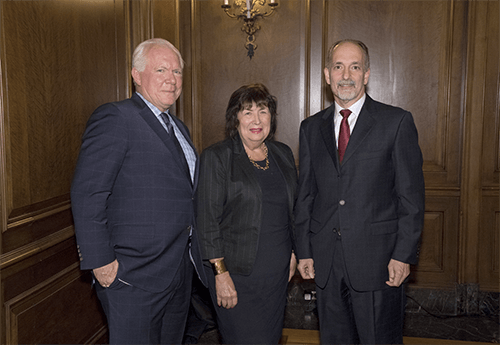
The UCI congratulates its two latest Champion of the Ocean Award honorees, Dr. Biliana Cicin-Sain, Director of the Gerard J. Mangone Center for Marine Policy at the University of Delaware, and Barry Gold, Environmental Program Director for the Walton Family Foundation.
Gold and Cicin-Sain were inducted into the prestigious group that includes members such as Leon Pannetta, Sylvia Earle and Jean-Michel Cousteau, at the 13th Annual Champion of the Ocean Awards Dinner held on Oct. 12.
View an album of photos from the event.
Upon accepting the award, Gold discussed his work leading the foundation’s freshwater and marine initiatives, which are dedicated to finding lasting solutions that benefit the environment and strengthen local economies. He recalled his previous work as director of Marine Conservation at the Gordon and Betty Moore Foundation, which provided grant funding to the UCI and several partners to develop the Mid-Atlantic Ocean Data Portal. Gold said he was pleased to see the growing impact that project is having throughout the region.
Gold’s career has also included tenures with the David and Lucile Packard Foundation, the Grand Canyon Monitoring and Research Center, the U.S. Department of the Interior, the U.S. House of Representatives’ Committee on Science, the U.S. National Academy of Sciences and the American Association for the Advancement of Science.
In addition to her work at the University of Delaware, Cicin-Sain is the founder and president of the Global Ocean Forum, which has brought together leaders from governments, NGOs, UN agencies, the private sector and scientific institutions from 110 countries to promote the implementation of international ocean agreements, analyze policy issues and advance international consensus on unresolved ocean issues. She is the author of over 100 publications in marine policy and a 2000 book,
The Future of U.S. Ocean Policy: Choices for the New Century, which presented a blueprint for national ocean policy reform in the U.S.
Cicin-Sain encouraged the Monmouth University science students in the room to choose a subject they feel passionate about, learn everything they can about it, and dedicate their full energy to it. “You as an individual can make a major difference,” Cicin-Sain said. “Don’t ever let anyone tell you that you can’t.”
The Champion of the Ocean Awards banquet is the UCI’s signature annual event, with all proceeds supporting student research at Monmouth University. Visit our awards page for a full list of past honorees.
Rumson and Monmouth University Announce Partnership to Build Marine Field Station on Navesink River
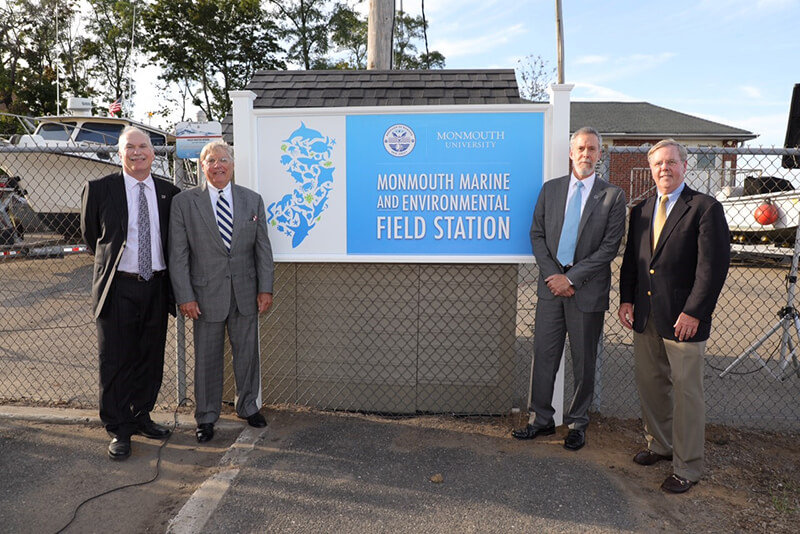
Pictured l-r: Monmouth University School of Science Dean Steven Bachrach; Rumson Mayor John Ekdahl; Monmouth University President Grey Dimenna; and Rumson Councilman Joe Hemphill.
Monmouth University and the Borough of Rumson unveiled plans on Sept. 26 to develop a new Monmouth Marine and Environmental Field Station on municipal property located on the banks of the Navesink River. The facility will provide unique opportunities for scientific research and educational collaboration between the professionals and students of the University and local schools.
Several Rumson and University officials were on hand for a ribbon-cutting ceremony at the site of the future field station. Tentative plans call for the addition of classroom, laboratory and meeting space above an existing sewer pump station on Avenue of the Two Rivers, behind the municipal building. The facility is located adjacent to the public boat ramp on the Navesink River, which will provide convenient access to the water for the University’s research vessels.
“This partnership is a win-win for Monmouth University and for our residents, especially students from our local schools, who have an interest and a thirst for science,” Mayor John Ekdahl said. “Our students will be able to take part and assist with hands-on research and class activities related to the waterways surrounding the Borough, which will be led by some of the most respected experts in their field.”
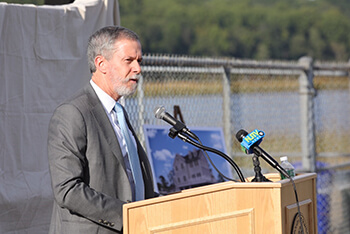
As the region’s leading private coastal university with our main campus just a mile from the ocean, Monmouth University has an important role to play in exploring the Jersey Shore’s marine environments and sharing that knowledge with our neighboring communities,” Monmouth University President Grey Dimenna said. “We are excited about the distinctive research opportunities at the field station for our students and faculty and thank our partners in Rumson for making this possible.”
Faculty from the University’s School of Science and Urban Coast Institute (UCI) have long used the boat ramp as a launch point for research in area water bodies such as the Navesink and Shrewsbury rivers, the Sandy Hook and Raritan bays, New York Harbor and the Atlantic Ocean. The University has already been granted access to the property to store vessels and other scientific equipment.
“This facility will help us build a better understanding of the scientific challenges facing the Navesink and Shrewsbury watersheds, from water quality issues to the rise of invasive species,” School of Science Dean Dr. Steven Bachrach said. “It will also be a great asset for the School of Science’s continued growth as one of the East Coast’s premiere marine and environmental biology programs.”
“The field station will allow our students to conduct hands-on, cutting-edge research projects that make a difference in the Two River communities,” UCI Director Tony MacDonald said. “These activities will prepare our students for their careers and perhaps attract a new generation of scientists.”
Rumson and the University will continue to collaborate on a site plan, a timetable, and fundraising to support the field station project. For more information, contact Karl Vilacoba at (732) 571-3688 or kvilacob@monmouth.edu.
See our album of photos from the kickoff event.
Research Indicates Climate Change Will Alter Makeup of Coastal Forests
When it comes to climate change, the evergreens are ever ready.

Monmouth University Associate Professor Dr. Pedram Daneshgar and a team of student researchers conducted a battery of saltwater exposure tests this summer on young trees that are native to New Jersey’s coastal forests. The experiments were designed to provide a glimpse at what the increased contact with wind-borne ocean spray and flood waters brought on by more frequent and intense coastal storms will mean for trees along the region’s waterfront areas.
Working with a large sample of American hollies, sassafras, black cherries, red maples and cedars, the researchers found that the deciduous trees were decidedly less salt-resistant. The results point to a future in which climate change will tilt natural selection in favor of the hollies and cedars, and begin to eliminate the others near beaches, estuaries and other brackish water bodies.
“They’ll try to survive, but if there’s no more seed source from parent trees, they won’t,” Daneshgar said.
The team conducted two types of experiments on the trees. In the first, the roots were submerged in a tank of saltwater for intervals of one, six and 12 hours to simulate flooding according to tide cycles. In the second set of tests, the trees were sprayed with concentrations of saltwater running from zero parts per 1,000 (a control) to 25 parts per 1,000 (comparable to levels in lower Barnegat Bay). Half of the trees were placed beneath a mesh sheet to emulate the shaded conditions young trees see at the bottom of a forest.
Across the board, the evergreens fared better after their exposure to both the spray bottles and the flood tank (although none of the trees survived the 12-hour flood).
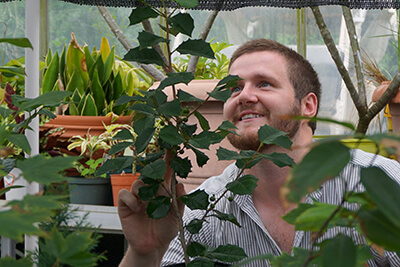
“The results are showing that deciduous, broad leaf species are starting to die off,” Monmouth University senior Jeff Dudek said as testing neared a close in August (see video above for full interview). “We’re starting to see leaf loss, curling of leaves, stunted growth. The prediction there is that we’ll start to see a more evergreen-dominated forest.”
In the fall, the researchers concluded by removing all of the trees’ leaves and weighing them. The step was designed to reveal which species had the strongest growth and maintained the strongest root systems in the face of the saltwater exposure.
The research was conducted in a greenhouse on the Monmouth University campus by Daneshgar with students Kelsey Connelly, Dudek and Matthew Francis. View photos of their work.
Daneshgar said the study results offer clear guidance for those planting near the shore: “Use salt-tolerant evergreens that have very waxy leaves.”
This research was funded by the UCI’s Marine Science and Policy Initiative, which is supported through the generosity of many private and corporate donors such as Santander Bank. If you would like to make a tax-deductible gift to the UCI, please use our Give a Gift Now contribution form.
Videos: Students Present Summer Research Projects
Twenty-two students who completed 11 UCI-funded projects shared their work with visitors at the Monmouth University School of Science Summer Research Program Symposium on Aug. 11. The annual event provides students and their faculty mentors with an opportunity to stage exhibits at the university’s scenic Erlanger Gardens and discuss their work with members of the public, faculty and their peers.
Watch the video above for an overview of the program and then scroll down to watch some of this year’s participants present their projects. Abstracts of all of this year’s projects are available. Special thanks to UCI Communications Assistant Jenna Frain, a student in Monmouth University’s Corporate and Public Communication graduate program, for her great work on the video above!
Gina Badlowski & Jarius Bradley
“Trends in the Abundance and Spatial-Temporal Variation of Sharks and Rays in New Jersey Coastal Waters”
Thomas Candiloro
“Bathymetry and Flood Mapping of Lake Como, New Jersey”
Jalize Canela & Eric Bryan
“Combating the Multidrug Resistant Bacterium ESBL-Escherichia coli Using Selected Essential Oils and Methyglyoxal”
Marissa DeTorre
“Seasonal Diet and Prey Selectivity of Atlantic Sturgeon in a Coastal Marine Aggregation”
Roberto Tanenbaum
“3D Hurricane Escape Mobile Application Using New Jersey’s Evacuation Routes”
Luke Tomkus
“3D Serious Building Game Demonstrating FEMA Methodologies to Reduce Severe Flood and Storm Damage to Homes”
Are Beach Replenishment Projects Causing a Surge in Rip Currents?
By Dr. Thomas Herrington, UCI Associate Director
Given the spike in reports of drownings and distressed swimmer incidents this summer, a lot of people have been asking whether beach replenishment could be causing stronger rip currents. While it’s possible in areas where projects were recently completed, it’s an unlikely explanation for a shore-wide trend.
Rip currents are created by a complex interaction of the underwater topography of the surf zone, the tide level, and wave heights and frequency. The larger the wave heights, the more prevalent rip currents become. For instance, they are always there during large storm events but we rarely care since no one is in the water.
The beach is always adjusting to reach an equilibrium with the wave energy at any given time. In other words, the shape of the beach is not random; it is optimized to dissipate breaking wave energy from the offshore sandbar across the surf zone to the waterline at the beach. The larger the waves, the farther offshore the sandbar moves, and vice versa. Rip currents occur much more frequently at the beginning of a wave event (storm) since the beach is significantly out of equilibrium with the wave energy. As the beach reaches its equilibrium point, rip currents tend to become less intense.
When beaches are rebuilt along the coast, sand is placed in basically a triangular wedge from the dry beach berm down into the surf zone. The “engineered” beach looks nothing like a natural beach. The assumption engineers make is that the waves will resort the sand on the beach into its natural balance. This results in rapid changes to the engineered beach by even small waves, leading to an increase in rip currents.
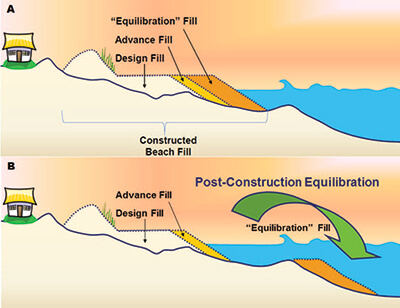
The diagram to the left (provided courtesy of the American Shore & Beach Preservation Association) shows how the ocean redistributes beach fill after construction.
Although new beaches can generate more rip currents, I don’t believe that’s what was happening this summer. We experienced many more days of moderate wave events than usual due to this summer’s weather pattern, which has generated more frequent frontal passages and associated storms. Even unrestored beaches experienced an increase in rip currents.
You can expect that to continue as the last of this hurricane season’s tropical cyclones sweep north over the Atlantic.
Video: Risk Communication in the Post-Sandy Era
The UCI and Mid-Atlantic Regional Council on the Ocean hosted a webinar on Aug. 15 that explored best practices for communicating the risks that major coastal storms present to the public. The session featured presentations by Rachel Hogan Carr, Executive Director of the Nurture Nature Center; Michael Oppegaard, Emergency Management Coordinator for the Monmouth County Sheriff’s Office – Office of Emergency Management; and Sarah Watson, who led the development of the National Oceanic and Atmospheric Administration’s (NOAA) Risk Communications Basics guidebook.
The discussion was made possible through grant funding provided by NOAA. Below are links to materials from the webinar.
- NOAA Risk Communications Basics guidebook
- Sarah Watson slides
- Rachel Hogan Carr slides
- Michael Oppegaard slides
- Monmouth County High Water Mark story map
UCI Contributes to Article in Journal Frontiers in Marine Science

UCI Director Tony MacDonald and Communications Director Karl Vilacoba were among the authors of an article in the journal Frontiers in Marine Science recounting the Mid-Atlantic Ocean Data Portal‘s origins and growth as an ocean planning tool. Read it here.
The article, “The Role of Mid-Atlantic Ocean Data Portal in Supporting Ocean Planning,” was prepared by members of the Portal project team, which includes the UCI, Rutgers University, The Nature Conservancy and Ecotrust. The lead author was Richard Lathrop of Rutgers University’s Center for Remote Sensing & Spatial Analysis (CRSSA).
Meet Doris Meyer
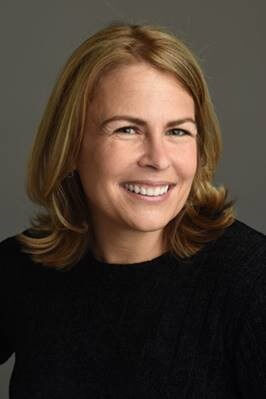
The UCI welcomes aboard Doris Meyer, who joined us in October as our new administrative assistant.
Doris received a degree in communications from the University of Maryland and her MAT from Monmouth University. She taught technology in the Oceanport School District before joining Monmouth University to work in higher education.
Doris grew up on the Shrewsbury River, and it was there she found her love of the sea. She learned to sail at 8, began competing at 10 and is still passionate about boating. She is an active member of the Shrewsbury Sailing & Yacht Club, where she volunteers for the Junior Sailing Program.
Don We Now Our UCI Apparel
UCI hoodies, tees, caps and beach towels are the perfect holiday gifts for your favorite ocean lovers! All sales proceeds support student-faculty research activities at Monmouth University.

